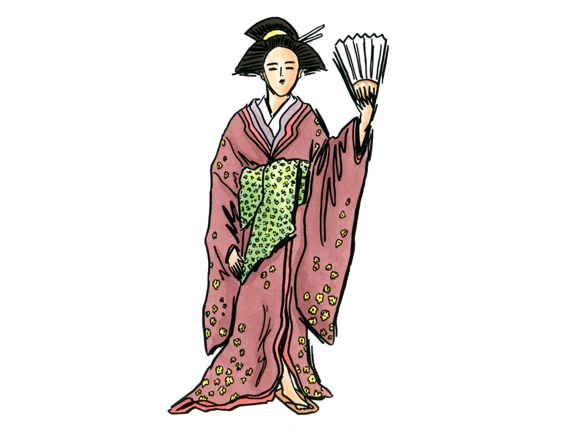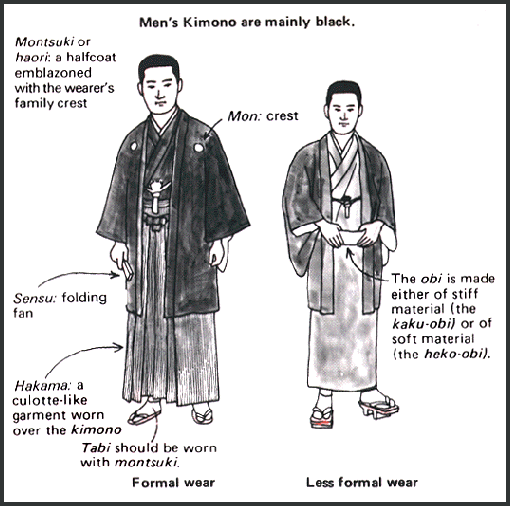Samurai Clothing Japanese clothing now Samurais wore baggy pants Hakama like a shirt with a winged vest. For staying at home you would usually wear a shorter haori but for formal occasions you would wear a longer one.

Japanese Fashion Through The Eras From Heian To Heisei Tokyo Weekender
They wore it straight down their backs a shining sheet of black tresses called kurokami.

. Kimono was once worn on a daily basis by most Japanese people. The Medieval Japanese have got it easy when it comes to clothing. Between the 12 th and 17 th Century the hitatare style of dress was popular.
Two female and male Kimono outfits. Medieval Japanese Clothing has become more complex over the Medieval Period. Ad Browse discover thousands of brands.
In Medieval Japan men and woman would wear kimonos. Now as long as you look good it doesnt matter if what you are wearing is practical or not. It would be worn with many other layers under the Kimono made with different.
A haori is a long and thin coat which was worn by men back in times of Feudal Japan. Materials and with different colours. Free easy returns on millions of items.
Although outfits today are lighter heels have brought down the practicality. Read customer reviews find best sellers. What was the most important clothing in medieval Japan.
Garments Worn Under Medieval Clothing. Samurai- Clothing Appearance. It was also greatly influenced by the design of Japanese homesTraditional Japanese fashions that are still worn today include.
Traditional clothing known as Japanese clothing 和服 wafuku including the national dress of Japan the kimono and Western clothing 洋服 yōfuku which encompasses all else not recognised as either national dress or the dress of another country. There are typically two types of clothing worn in Japan. The length of the haoris can change for the occasion you would most likely wear them for.
Fashion and Clothing in Medieval Japan by churrio C. My Comparison Japanese clothing has changed a lot since the Medieval period. The designs are not only different but the ways and materials they are made with has altered.
They consist of long sleeves and go from shoulders to the heels. Although their dresses were heavy they did lighten up during the years. In the Japanese attire category you will find pieces for men and women ranging from elegant kimono to samurai clothing.
The pieces of clothing are suited to the seasons they are worn in. Peasant- Clothing Appearance. Almost everyone in feudal Japan wore a kimono.
Samurais would wear a kimono everyday. These figures often seen in popular movies and games about pre-modern Japan are only loosely based on reality. The peasants merchants and artisans wore rough kimonos made out of cotton.
In fact many different types of people helped shape the medieval period. Kimonos came during the Hein period 794CE - 1185CE. Basically they consisted of a shirt or under-tunic stockings or hose and some kind of underpants or breeches for men.
This fashion began as a reaction against imported Chinese Tang Dynasty fashions which were much shorter and included ponytails or buns. Floral Designs such as blossoms with bright colours. It has changed the materials that the clothing is made from and the style aswell.
An everyday clothing for Japanese people would be called a Kimono. It was influenced by factors such as battle and the weather. Unlike the common kimono hitatare was a two-piece costume though comparably flowing and ample Yoroi hitatare was a snugger version for use under armor.
Medieval Europe Feudal Japan Fashion Medieval Europe Feudal Japan Similarities Queens and Kings Emperor Shogun Daimyo Fashion style represented their class in the society Clothing depended on how wealthy they were Warriors wore protective battle wear instead of nice clothes. Patterns such as leaves. Darker Fabrics and more layers.
During the Medieval days in Japan clothing was the best part in dressing up and is still now today. Our Japanese pants and warrior kimono make a great choice for martial arts practice as well. Free shipping on qualified orders.
Traditional Japanese fashion represents a long-standing history of traditional. The women of the imperial court in Heian Japan 7941185 CE grew their hair as long as possible. The Traditional Heian Japanese clothings worn then were kimonos which consisted if many layers and different materials like silks etc and many colours were used for their clothing considering the fact that they were very creative and loving for the different colours they could put into their cloths.
Medieval Japan may call to mind honorable sword-wielding samurai and stealthy ninja assassins. Upper-class women wore perhaps the most famous wardrobe item from Japanese culture the kimono. Empress- Clothing Appearance.
Japanese vests Japanese jackets and Japanese belts are all common items that can be paired with a variety of outfits. Clothing The Japenese have a rich and very unique fashion. Throughout much of the Middle Ages and in most societies the undergarments worn by both men and women didnt substantially change.

Japanese Clothes Footwear Yukatas Uniforms And Men S Handbags And Skirts Facts And Details

History Of Kimono The Edo Period Owlcation


0 comments
Post a Comment